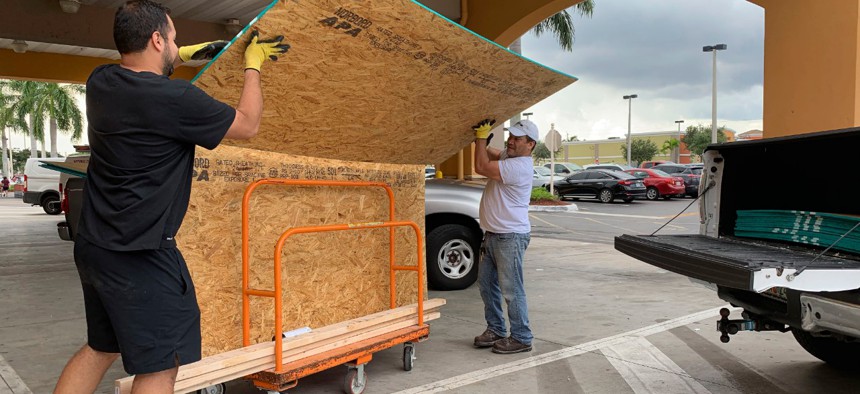Trump’s feud is stupid, and the decision to move the money is a gamble that could very well look like malpractice down the road. But it’s useful to remember that in the broader scheme of hurricane relief, the federal government, and especially the president, are not the most important responders or even the primary ones—though the feds often end up taking the blame or the credit. Local agencies are a part of the puzzle: Florida has extensive experience with hurricanes, of course, and the state’s Division of Emergency Management is often regarded as a national model. But ordinary citizens are the underappreciated lynchpin of disaster response.
When a Hurricane Hits, Neighbors Are the Real First Responders
The best determinant of how well a community fares in a storm is often not what happens after landfall, but what it was like before the wind and water hit.
There’s not much to do when a hurricane or tropical storm is inbound—dropping nuclear weapons on them isn’t really an option. Evacuate if ordered, make sure you’ve stocked up on water, canned food, and batteries, and then sit down and begin a robust round of political recriminations.
As Dorian’s gray, wild clouds approach Florida, having largely spared Puerto Rico, the recriminations are in full swing. President Donald Trump, whose default move is to make any story about him, took the opportunity to reopen his feud with political leaders in Puerto Rico. Meanwhile, NBC News reports that the Trump administration has diverted $271 million from a Federal Emergency Management Agency disaster-relief fund to pay for detention facilities at the Mexican border.
There are stories of civilians helping each other after every big disaster, but 2017’s Hurricane Harvey produced an indelible example with the Cajun Navy, a half–Good Samaritan and half-lunatic volunteer force that went out in personal boats to rescue people. While some observers held up the prominence of the Cajun Navy as an example of governmental failures, emergency managers have, in recent years, begun to factor such efforts into their calculations about how to handle major crises.
“When you step back and look at most disasters, you talk about first responders—lights and sirens—that’s bullshit,” the former FEMA director Craig Fugate told me in 2015. “The first responders are the neighbors, bystanders, the people that are willing to act.”
In part, this emphasis on neighbors helping one another is simple realism. In a big enough disaster, no state or federal agency can move all the resources people will need into an area immediately, especially if critical infrastructure such as roads and communications networks are destroyed. In part, it’s a realization that though a storm is devastating, it’s not often annihilating, and some of what people need is already on the ground. And in part, it’s designed to empower people after a storm. Fugate led a charge to stop referring to them as “victims,” with its implication of helplessness, and refer to them instead as “survivors.” Incorporating them into the formal relief plans returns their agency.
The importance of people helping one another, whether they’re semi-organized teams like the Cajun Navy or just individuals checking on an elderly neighbor, means that the best determinant of how well a community fares in a storm is often not what happens after landfall, but what it was like before the wind and water hit.
“We know what makes people safer in disasters is close social networks, more equality in the community, and having high social capital,” says Jacob Remes, a historian and disaster scholar at NYU. “The sort of work you have to do to build communities that will do well in disaster, you can’t do in the days or the week before the disaster. You have to be doing them all the time.”
That means places that have bustling public spaces, walkable streetscapes, lower crime, and better housing stock tend to fare better, because people are more likely to know their neighbors and consequently feel an obligation to them.
“Because of segregation by race and class, the communities that tend to have these physical aspects that make them safer are also where people who are richer and better educated and whiter live,” Remes says. That means other demographic groups are more vulnerable when storms hit—though there are plenty of examples of poorer but tight-knit communities reacting effectively in places such as post-Katrina New Orleans.
While Florida has the advantage of years of hurricane experience, it also features lots of car-centric suburbs that don’t encourage much social interaction, which makes them more vulnerable in the aftermath of storms.
Considering these community elements as storm preparedness is a bit of a double-edged sword. Once the winds have calmed and the water has receded, officials quickly begin to talk about rebuilding and how to bounce back.
“What that ignores is, how is a disaster created by the choices we’ve made?” Remes says. “Do we really want to go back?”
But there’s a more positive way to view this too. Encouraging tighter-knit, more livable communities that bounce back from storms more quickly creates improvements in quality of life that accrue even when there’s no hurricane. Stronger communities are also more resilient—filled with people who will be able to help one another in the coming days, when Dorian hits.





